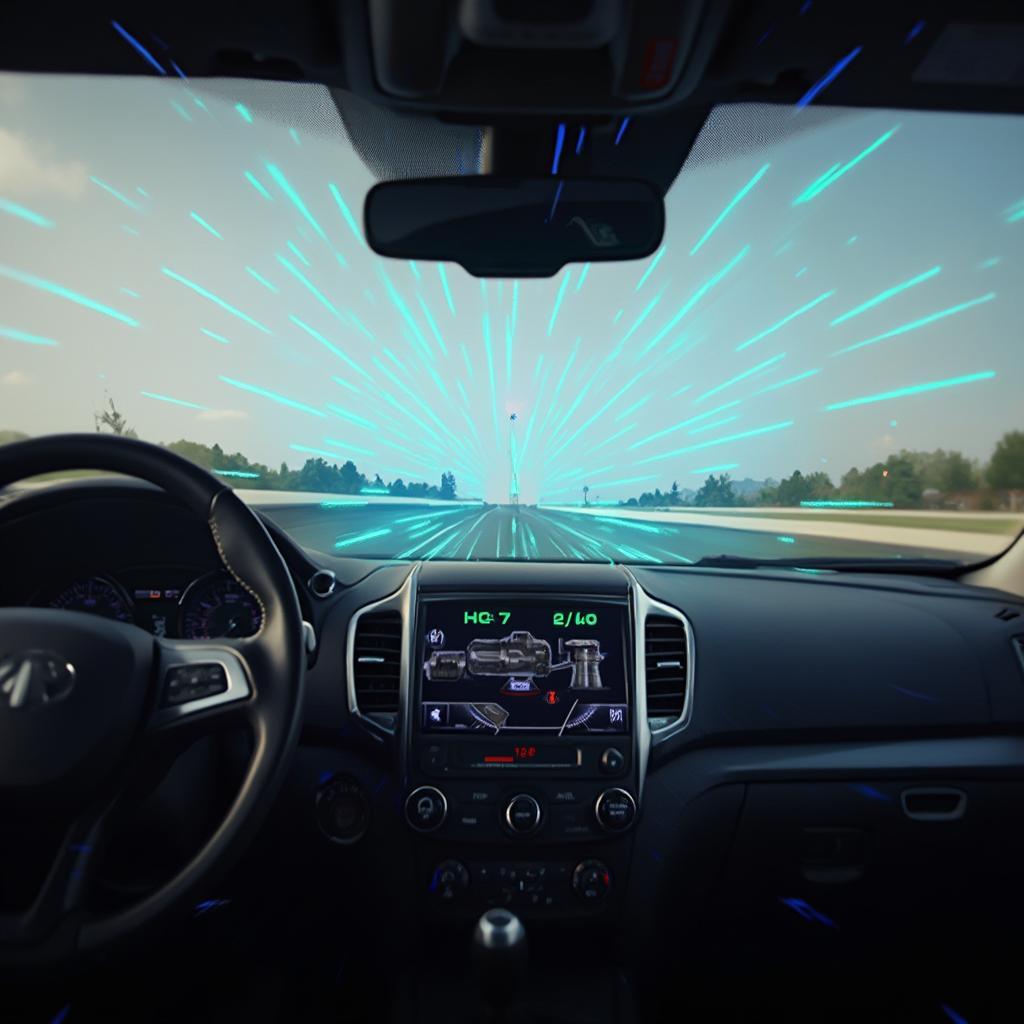An OBD2 head-up display (HUD) projects crucial vehicle information directly onto your windshield, keeping your eyes on the road. This guide dives into everything you need to know about OBD2 HUDs, from their functionality and benefits to choosing the right one for your needs.  OBD2 HUD displaying speed and RPM on a car windshield
OBD2 HUD displaying speed and RPM on a car windshield
Understanding OBD2 HUD Technology
OBD2 HUDs tap into the wealth of data available through your car’s obd2 socket. They pull information like speed, RPM, fuel consumption, coolant temperature, and even diagnostic trouble codes (DTCs), then display it clearly in your line of sight. This eliminates the need to glance down at the instrument cluster, improving safety and situational awareness. This technology seamlessly integrates with most vehicles manufactured after 1996, providing a valuable upgrade for drivers seeking enhanced visibility and real-time data. They draw power directly from the OBD2 and EUOBD port, simplifying installation.
How Does an OBD2 HUD Work?
The socket obd2 acts as the communication hub. The HUD retrieves data, processes it, and projects it onto a transparent combiner or directly onto the windshield. This projected image appears as if it’s floating a few feet in front of the car, allowing you to monitor key information without taking your eyes off the road.
Benefits of Using an OBD2 Head-Up Display
The advantages of using an OBD2 HUD are numerous:
- Enhanced Safety: Keeping your eyes on the road is paramount. OBD2 HUDs minimize distractions, allowing you to react faster to changing road conditions.
- Increased Situational Awareness: Having vital information readily available allows for better decision-making, especially in challenging driving situations.
- Improved Driving Experience: The sleek and futuristic feel of a HUD adds a touch of modernity to any vehicle.
- Early Warning System: Many HUDs display diagnostic trouble codes, alerting you to potential issues before they become major problems.
Choosing the Right OBD2 HUD
Selecting the right OBD2 HUD depends on your individual needs and preferences:
-
Display Size and Resolution: Opt for a display that is large enough to be easily readable but not so large that it obstructs your view. Higher resolution ensures clarity and crispness.
-
Features: Consider which data points are most important to you. Some HUDs offer additional features such as GPS navigation, speed limit warnings, and even smartphone integration.
-
Compatibility: Double-check compatibility with your vehicle’s make and model to ensure seamless integration.
What to Look for in a Quality OBD2 HUD?
Look for HUDs with adjustable brightness, automatic dimming, and clear, easy-to-read displays. A compact and unobtrusive design is also crucial. Consider features like over-speed warnings, fatigue alerts, and dash cam obd2 stats integration for enhanced safety.
Common OBD2 HUD Questions
While OBD2 HUDs are user-friendly, some questions commonly arise:
-
Will it work with my car? Most vehicles manufactured after 1996 are compatible, but checking your specific make and model is always recommended.
-
Is it easy to install? Installation is generally plug-and-play, simply connecting to the OBD2 port.
Conclusion
OBD2 head-up displays offer a significant upgrade to your driving experience. By providing crucial information directly in your line of sight, they enhance safety, increase situational awareness, and add a touch of modern technology to your vehicle. Choose the right OBD2 HUD, and experience the benefits of a clearer view.
FAQs
-
What is the primary function of an OBD2 HUD? To display vital vehicle information directly onto the windshield.
-
How does an OBD2 HUD improve safety? By minimizing distractions and keeping the driver’s eyes on the road.
-
Are OBD2 HUDs compatible with all vehicles? Most vehicles after 1996 are compatible, but check your specific make and model.
-
Is installation complicated? No, installation is generally simple plug-and-play through the OBD2 port.
-
What key features should I look for in an OBD2 HUD? Clear display, adjustable brightness, automatic dimming, and compatibility with your vehicle.
-
Where can I find more information on streetwise obd2 manual? Check out our dedicated page for detailed information.
-
What are the benefits of integrating dash cam data with an OBD2 HUD? It enhances safety and provides valuable data in case of accidents.
For support contact WhatsApp: +1(641)206-8880, Email: cardiagtechworkshop@gmail.com or visit 789 Elm Street, San Francisco, CA 94102, USA. We have 24/7 customer service.
